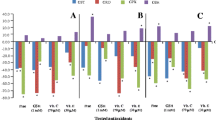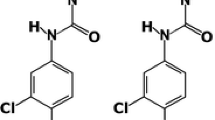Abstract
In a study of potential carcinogenicity of pesticides, Piritione, metolachlor (in the form of Dual and VUCHT 524) and Supercypermethrin (in the form of Supercypermethrin EC and Supercypermethrin TP) were assayed for induction of anchorage independent growth of BHK21 cells and morphological transformation of Syrian hamster embryo cells. The activity of these substances in both transformation assays was compared to the activity of the direct-acting ultimate carcinogen N-methyl-N-nitrosourea. In comparison to the very strong transforming activity of N-methyl-N-nitrosourea all pesticides tested with or without S9 fraction manifested a very weak, weak, medium or strong effect. The ability to induce anchorage independent growth was graded as follows: Dual < Supercypermethrin EC < Supercypermethrin TP ≤ Piritione < VUCHT 524. Results of Syrian hamster embryo cell transformation assay were very similar to the BKH21 transformation assay. VUCHT 524 strongly induced transformation whereas Dual was inactive. Piritione and Supercypermethrin EC and Supercypermethrin TP elicited a slight but significant positive response.
Similar content being viewed by others
References
BARRETT, J.C., CRAWFORD, B.D., GRADY, D.L., HESTER, L.D., JONES, P.A., BENEDICT, W.F., and TS'O, P.O.P., (1977). “Temporal acquisition of enhanced fibrinolytic activity by Syrian hamster embryo cells following treatment with benzo(a)pyrene.” Cancer Res. 37:3815–3823.
BARRETT, J.C. and TS'O, P.O.P. (1978). “Evidence for the progressive nature of neoplastic transformation in vitro.” Proc. Natl. Acad. Sci. USA. 75:3761–3765.
BOUCK, N. and DIMAYORCA, G. (1979). “Evaluation of chemical carcinogenicity by in vitro neoplastic transformation.” Methods in Enzymology 57:296–302.
BOUCK, N. and DIMAYORCA, G. (1980). “The mutagenic nature of in vitro transformation of BHK cells by chemical carcinogens.” Adv. Mod. Environ. Toxicol. 1:447–466.
BOUCK, N. and DIMAYORCA, G. (1982). “Chemical carcinogens transform BHK cells by inducing a recessive mutation.” Molecular and Cellular Biology 2:97–105.
BROOKS, T.M. (1980). “Toxicity studies with agricultural chemicals: mutagenicity studies with RIPCORD in microorganisms in vitro and in the host-mediated assay.” Sittingbourne, Shell Research. TGLR 80:59.
CARVER, J.M., ADAIR, G.M., and WANDERS, D.L. (1980). “Mutagenicity by testing in mammalian cells. II. Validation of multiple drug resistance markers having practical application for screening potential mutagens.” Mutation Res. 72:207–230.
CHASIN, L.A. (1973). “The effect of ploidy on chemical mutagenesis in cultured Chinese hamster cells.” J. Cell Physiol. 82:299.
DANIEL, M.R. and DENHEL, J.M. (1980). “Factors affecting the performance of the BHK21 cell transformation test.” Tenth annual meeting of EEMS on environmental mutagenesis, Athens, Greece, Abstracts p.148.
DEAL, L.M. and HESS, F.D. (1980). “An Analysis of the growth inhibitory characteristics of alachlor and metolachlor.” Weed. Sci. 28:168–175.
DUŠINSKÁ, M. and SLAMENOVÁ, D. (1982). “Use of mammalian cells in screening for chemical carcinogens.” Biologické listy (in Slovak) 47:264–278.
HANNA, P.J. and DYER, K.F. (1975). “Mutagenicity of organophosphorus compounds in bacteria and Drosophila” Mutation Res. 28405–420.
HEIDELBERGER, C., FREEMAN, A.E., PIENTA, R.J., SIVAK, A., BERTRAM, J.S., CASTO, B.C., DUNKEL, V.C., FRANCIS, M.W., KAKUNAGA, T., LITTLE, J.B., and SCHECHTMAN, L.M. (1983). “Cell transformation by chemical agents: a review and analysis the literature.” Mutation Res. 114:283–385.
ISHII, Y., ELLIOTT, J.A., MISHRA, N.K., and LIEBERMAN, M.W. (1977). “Quantitative studies of transformation by chemical carcinogens and ultraviolet radiation using a subclone of BHK21 clone 13 Syrian hamster cells.” Cancer Res. 36:558–563.
JENSSEN, D. and RAMEL, C. (1980). “The micronucleus test as part of a short-term mutagenicity test program for the prediction of carcinogenicity evaluated by 143 agents tested.” Mutation Res. 75:191–202.
JONES, C.A., HUBERMAN, E., CALLAHAM, M.F., TU, A., LUBET, R.A., AVERY, M.D., and KOURI, R.E. (1988). “An interlaboratory evaluation of the Syrian hamster embryo cell transformation assay using eighteen coded chemicals.” Toxic. in Vitro. 2:103–116.
KUROKI, T., MALAVEILLE, C., DREVON, C., PICOLLI, C., MACLEAD, M., and SELKIRK, J.K. (1979). “Critical importance of microsome concentration in mutagenesis assay with V79 Chinese hamster cells.” Mutation Res. 63:259–272.
KURTZ, P.J., DESKIN, R., HARRINGTON, M. (1989) “Pesticides.” In: Principles and Methods of Toxicology (A.W. Hayes, ed.) pp. 137–167. Raven Press, Ltd., New York.
LEBOEUF, R.A., KERCKAERT, G.A., POELEY, J.A., and RAINERI, R. (1989). “An interlaboratory comparison of enhanced morphological transformation of Syrian hamster embryo cells cultured under conditions of reduced bicarbonate concentration and pH.” Mutation Res. 222:205–218.
PIENTA, R.J., POILEY, J.A., and LEBHERZ, W.B. III (1977). “Morphological transformation of early passage golden Syrian hamster embryo cells derived from cryopreserved primary cultures as a reliable in vitro bioassay for identifying diverse carcinogens.” Int. J. Cancer 19:642–655.
PIENTA, R.J., POILEY, J.A., and RAINERI, R. (1983). “Application of transformation systems.” Annals of the New York Academy of Sciences 47:267–283.
PPLEWA, M.J., WAGNER, E.D. and GENTILE, G.J. (1984). “An evaluation of the genotoxic properties of herbicides following plant and animal activation.” Mutation Res. 136:233–245.
PLUYMEN, M., DREVON, C., MONTESANO, R., MALAVEILLE, C., HAUTEFEUILLE, A. and BARTSCH, H. (1984). “Lack of mutagenicity of synthetic pyrethroids in Salmonella typhimurium strains and in V79 Chinese hamster cells.” Mutation Res. 137:7–15.
PURCHASE, I.F.H., LONGSTAFF, E., ASHBY, J., STYLES, J.A., AANDERSON, D., LEFEVRE, P.A., and WESTWOOD, F.R. (1978). “An evaluation of 6 short-term tests for detecting organic chemical carcinogens.” Br. J. Cancer 37:873–959.
SEILER, J.P. (1975). “Evaluation of some pesticides for mutagenicity.” In: The Prediction of Chronic Toxicity from Short-Term Studies, Proc. Soc. Study Drug Tox. 17:398–404.
SLAMEŇOVÁ, D. and GÁBELOVÁ, A. (1980). “The effects of sodium azide on mammalian cells cultivated in vitro.” Mutation Res. 17:253–261.
SLAMEŇOVÁ, D., DUŠINSKÁ, M., BUDAYOVÁ, E., and GÁBELOVÁ, A. (1983a). “The genetic effects of the cytostatic drug TS 160 on Chinese hamster fibroblasts in vitro.” Mutation Res. 116:431–440.
SLAMEŇOVÁ, D., DUŠINSKÁ, M., and GÁBELOVÁ, A. (1983b). “Mutagenic effect of nitrofurylacrylic acid on V79 cells under hypoxic conditions.” Neoplasma 30:7–12.
SLAMEŇOVÁ, D., DUŠINSKÁ, M., and NÁDASKÁ, M. (1984). “Occurrence of induced 6-thioguanine-resisaant colonies in synchronized V79 cells after treatment with ftorafur. Effects of the S9 fraction.” Neoplasma 31:339–345.
SLAMEŇOVÁ, D. and GÁBELOVÁ, A. (1986). “The influence of multiple mutagenic treatment on the occurrence of 6-thioguanine-resistant mutants in dividing V79 cells” Mutation Res. 159: 91–97.
SLOAN, M.E. and CAMPER, N.D. (1986). “Effects of alachlor and metolachlor on cucumber seedlings.” Environ. Exp. Botany. 26:1–7.
STYLES, J.A. (1977). “A method for detecting carcinogenic organic chemicals using mammalian cell in culture. Br. J. Cancer 36:558–563.
WIEBEL, F.J., BROWN, S., WATERS, H.L., and SELKIRK, J.K. (1977). “Activation of xenobiotics by monooxygenases: cultures of mammalian cells as analytical tool.” Arch. Toxicol. (Berl.) 39: 133–148.
WORLD HEALTH ORGANIZATION Geneva (1986). “Organophosphorus Insecticides: A General Introduction” Environmental Health Criteria 63:1–181.
WORLD HEALTH ORGANIZATION Geneva (1989) “Cypermethrin” Environmental Health Criteria 82: 1–154.
ZENDZIAN, R.P. (1986). “Toxicology chapter of the metolachlor registration standard.” Office of Pesticide and Toxic Substances, U.S.Environmental Protection Agency, Washington, D. C.
Author information
Authors and Affiliations
Rights and permissions
About this article
Cite this article
Slameňová, D., Dušinská, M., Gábelová, A. et al. An evaluation of three pesticides: Piritione, supercypermethrin and metolachlor in transformation bioassays of BHK21 and hamster embryo cells. Cell Biol Toxicol 8, 217–231 (1992). https://doi.org/10.1007/BF00156732
Issue Date:
DOI: https://doi.org/10.1007/BF00156732




